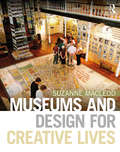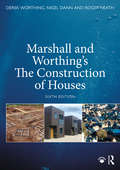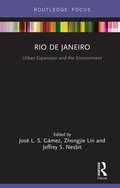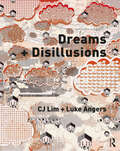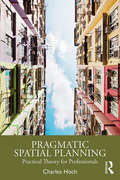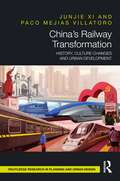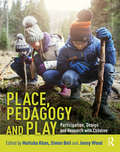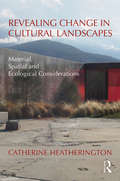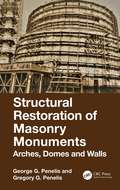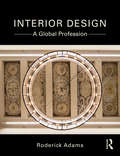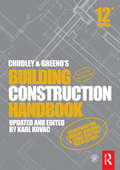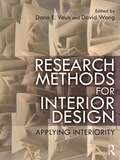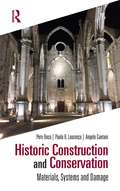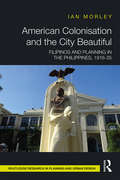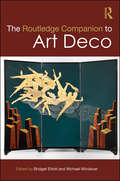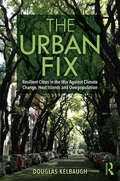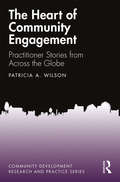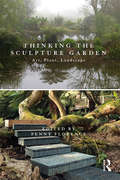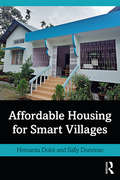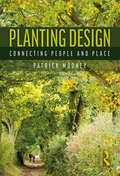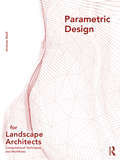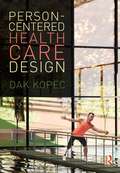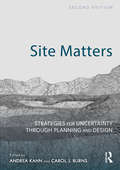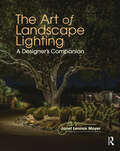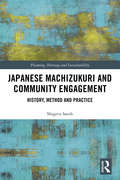- Table View
- List View
Museums and Design for Creative Lives
by Suzanne MacLeodMuseums and Design for Creative Lives questions what we sacrifice when we allow economic imperatives to shape public museums, whilst also considering the implications of these new museum realities. It also asks: how might we instead design for creative lives? Drawing together 28 case studies of museum design spanning 70 years, the book explores the spatial and social forms that comprise these successful examples, as well as the design methodologies through which they were produced. Re-activating a well-trodden history of progressive museum design and raising awareness of the involvement of the built forms in how we feel, think and act, MacLeod provides strategies and methods to actively counter the economisation of museums and a call to museum makers to work beyond the economic and advance this deeply human history of museum making. Museums and Design for Creative Lives will be of great interest to academics and students in museum studies, gallery studies, heritage studies, arts management, communication and architecture and design departments, as well as those interested in understanding more about design as a resource in museums. The book provides a valuable resource for museum leaders and practitioners.
Marshall and Worthing's The Construction of Houses
by Derek Worthing Duncan Marshall Roger Heath Nigel DannThe sixth edition of The Construction of Houses builds on the success of the previous five editions. The book provides a comprehensive introduction to the principles and processes of the construction of houses and their services. As such it is aimed at providing a broad understanding of domestic building construction for students as part of their academic studies and as a useful information source for practitioners. The existing chapters have all been updated and most of them expanded to take account of changes to dwelling house construction since the last edition and there are new chapters on ‘Modern Methods of Construction’ and ‘Regulatory controls and building standards’. Additionally, many new and/or updated photographs and diagrams have been added. As with the previous editions, the authors have concentrated on presenting current mainstream approaches to the construction of houses. The detailed, yet accessible, text that is supported by hundreds of coloured photographs and diagrams provides clear explanations of the many complex processes that go into the building of a house. A deeper insight into modern construction is also given by the book’s consideration of historical building techniques from the 18th century onwards in order to illustrate how and why we build houses in the way we do now.
Rio de Janeiro: Urban Expansion and the Environment (Built Environment City Studies)
by Zhongjie Lin José L. S. Gámez Jeffrey S. NesbitUsing Rio de Janeiro as the case study city, this book highlights and examines issues surrounding the development of mega-cities in Latin America and beyond. Complex dynamics of urbanization such as mega-event-driven development, infrastructure investment, and informal urban expansion are intertwined with changing climatic conditions that demand new approaches to sustainable urbanism. The urban conditions facing 21st century cities such as Rio emphasize the need to revisit urban forms, reintegrate infrastructure, and re-evaluate practices. With contributions from 15 scholars from several countries exploring urbanism, urbanization, and climate change, this book provides insights into the contextual and environmental issues shaping Rio in the age of globalization. Each of the book’s three sections addresses an interdisciplinary range of topics impacting urbanism in Latin America, which will be accessible to researchers and professionals interested in urbanization, urban design, sustainability, planning, and architecture.
Dreams + Disillusions
by CJ Lim Luke AngersDreams + Disillusions explores the plethora of ideas and ideologies that have shaped and reshaped cities in profound ways. However, unlike a conventional title on the history of urbanism and architecture, its research fluctuates between the world of concrete reality and the multiple universes that exist in lucid prose, poetic visions, and the outrageous imaginations of history’s greatest and most (in)famous minds. In their thoughts are the foundations for political trends and new civilisations, alternative mappings and unlikely phenomena. The six chapters reveal dreams that were fundamental to the origin of great cities, underpinning the stories of the many lives within; and how, through circumstance or manipulation, fortunate coincidence or planned perfection, desires are sometimes left defeated and disillusioned.Myth and belief. Tradition and logic. Revolution and marginalisation. Ignorance and hubris. Sins and excess. Seasons and climate. Continuously interacting, shifting to enlighten and to enrage, these themes combine critical thinking with deep-rooted influences and new agencies that are a true sign of the times. The 18 illustrated speculations provide an abundance of curious imaginings, diverse provocations and satirical criticism. While there are distinctions between dreams and disillusions, could virtues be made of sins, or sensitivity be borne from hubris? Could progress advocate tradition, or should we re-attempt revolutions formerly experienced as disillusionments? Whether by bold gestures or by subtle attrition, cities are continually re-written crucibles for the human condition. In this book, we develop a better understanding of the discourse of cities tailored to the determining factors of climate, resources, and humanity’s idiosyncrasies to address a world in crisis.
Pragmatic Spatial Planning: Practial Theory for Professionals
by Charles HochInstead of seeking theory to justify practical professional judgments this book describes how professionals can and should use theory to guide these judgments. Professional spatial planning in the US, and globally, continues to suffer from a weak conceptual grasp of its own practice. Practitioners routinely recognize the value and wisdom of practical judgment finely attuned to context, nuance and complexity; but later offer banal testimony and glib stories of ‘just so’ best-practice discrediting the ambiguity of their own experience. The chapters in this book provide a vocabulary tailored to the conventions of practical judgment, challenging students and practitioners to treat professional expertise as work in progress rather than ‘best’ practice. Instead of seeking theory to justify practical professional judgments, Hoch describes how professionals can and should use theory to guide these judgments. The pragmatist plan helps cope with complexity rather than control it, making it invaluable in the anyone’s pursuit of a planning career. This book will appeal to a wide cross section of students and scholars, especially those working in urban planning, public policy, and government.
China’s Railway Transformation: History, Culture Changes and Urban Development
by Junjie Xi Paco Mejias VillatoroThis book investigates China’s railway transformation through history, along with culture changes and urban development. The book begins by looking at the background of China and the history and growth of railway development in China through five key phases, followed by assessing the cultural changes in the railway carriage and exploring how these are linked to social equality and national provisions. The core of this book aims to analyse the Chinese urban transformation through the development of the high-speed rail (HSR) infrastructure in China. Eleven important new HSR stations in mainland China, plus the new Hong Kong West Kowloon Station, have been selected to contextually explore how HSR infrastructures have affected the development of the Chinese urban context. The selected case studies are the stations of Beijing South, Wuhan, Shanghai Hongqiao, Guangzhou South, Xi’an North, Nanjing South, Chengdu East, Tianjin West, Zhengzhou East, Hangzhou East and Hong Kong West Kowloon. All of these were built between 2008 and 2018. In these case studies, the location and the intentions and success of promoting urban development are analysed and assessed. Following this, the book further investigates the peculiarities of the new HSR stations in China in comparison with stations in Europe. An assessment framework is established to evaluate the Chinese case studies comparatively with significant cases in Europe, attending to the urban structure of the area, the architectural quality, the functional diversity and the quality of the public space generated in the surrounding area.
Place, Pedagogy and Play: Participation, Design and Research with Children
by Matluba KhanPlace, Pedagogy and Play connects landscape architecture with education, psychology, public health and planning. Over the course of thirteen chapters it examines how design and research of places can be approached through multiple lenses – of pedagogy and play and how children, as competent social agents, are engaged in the process of designing their own spaces – and brings a global perspective to the debate around child-friendly environments. Despite growing evidence of the benefits of nature for health, wellbeing, play and learning, children are increasingly spending more time indoors. Indeed, new policy ideas and public campaigns suggest how children can become better connected with nature, yet linking outdoor space to pedagogy is largely overlooked in research. By focusing on three themes within these debates, place and play; place and pedagogy; and place and participation, this book explores a variety of angles to show that best practice requires dialogue between research disciplines, designers, educationists and psychologists, and a move beyond seeing the spaces children inhabit as the domain only of childhood professionals. Through illustrated case studies this book presents a wider picture of the state of childhood today, and offers practical solutions and further research avenues that promote a more holistic and internationally focused perspective on place, pedagogy and play for built-environment professionals. Chapter 12 of this book is freely available as a downloadable Open Access PDF under a Creative Commons Attribution-Non Commercial-No Derivatives 4.0 license.
Revealing Change in Cultural Landscapes: Material, Spatial and Ecological Considerations
by Catherine HeatheringtonThis book explores different design approaches to revealing change within a landscape, and examines how landscape designers bring together the cultural context of a specific place with material, spatial and ecological considerations. Revealing Change in Cultural Landscapes includes case studies such as Gilles Clément’s Jardin du Tiers-Paysage in France, the Brick Pit in Sydney, Australia and Georges Descombes’ Renaturation of the River Aire in Switzerland to uncover the insights of designers. In doing so, Catherine Heatherington considers the different ways designers approach the revealing of change and how this informs a discussion about people’s perceptions and understanding of landscape. With over 100 images and contributions from Jacky Bowring, Dermot Foley and Krystallia Kamvasinou, this book will be beneficial for students of landscape and landscape architecture, particularly those with an interest in how landscapes change over time and how this is perceived by both designers and visitors.
Structural Restoration of Masonry Monuments: Arches, Domes and Walls
by George G. Penelis Gregory G. PenelisHistoric structures need to be restored in line with international guidance and charters developed by architects and archaeologists, but technical understanding of structural engineering and materials is crucial, particularly with respect to response to earthquake loading. This guide to structural assessment and restoration of masonry monuments and historical buildings outlines the techniques, materials and design procedures used. It begins with principles, theory and practice and then presents case studies. The assessment focusses on Building materials and construction techniques used in the past The mechanics of masonry The structural behaviour of masonry monuments and historical buildings In-situ investigation and laboratory tests for existing and restoration materials. The restoration elaborates on Techniques and materials available for structural restoration Structural analysis and design Deciding on the restoration scheme Emergency measures and protective measures.
Interior Design: A Global Profession
by Roderick AdamsAs the globe shrinks and the concept of distance diminishes, this text challenges the current status quo by identifying the cohesions and specialisations of design communities across the continents. It sets out an international spatial design landscape, identifying and contouring global design practice and design hotspots from a range of case studies, interviews and design practice perspectives. Using a range of interior environments, the chapters link the origins, trends and perceptions of the interior to create new insight into trans-global design. The book expands, but also coheres the interior design discipline to ensure the subject continues to grow, develop and influence the inhabitations of the world. The book features a wealth of pedagogical elements including: Beautifully designed with over 100 full colour illustrations, photographs and examples of design work Maps and diagrams which highlight hotspots of design across the globe, providing strong graphic information Interview panels featuring professional insights from designers across the globe ‘Employability’ boxes, providing a good tips guide for students gaining employment across the globe ‘International Dimension’ boxes which strengthen the scholarship of studying interior design in a globalised way ‘Design Oddities’ box which brings into focus any new or contextual facts that help contextualise the global interior.
Chudley and Greeno's Building Construction Handbook
by Roy Chudley Roger Greeno Karl KovacThe 12th edition of Chudley and Greeno’s Building Construction Handbook remains THE authoritative reference for all construction students and professionals. The principles and processes of construction are explained with the concepts of design included where appropriate. Extensive coverage of building construction practice, techniques and regulations representing both traditional procedures and modern developments are included to provide the most comprehensive and easy to understand guide to building construction. This new edition has been updated to reflect recent changes to the building regulations, as well as new material on modern methods of construction, greater emphasis on sustainability and a new look interior. Chudley and Greeno’s Building Construction Handbook is the essential, easy-to-use resource for undergraduate and vocational students on a wide range of courses including NVQ and BTEC National, through to Higher National Certificate and Diploma, to Foundation and three-year Degree level. It is also a useful practical reference for building designers, contractors and others engaged in the construction industry.
Research Methods for Interior Design: Applying Interiority
by Dana E. VauxInterior design has shifted significantly in the past fifty years from a focus on home decoration within family and consumer sciences to a focus on the impact of health and safety within the interior environment. This shift has called for a deeper focus in evidence-based research for interior design education and practice. Research Methods for Interior Design provides a broad range of qualitative and quantitative examples, each highlighted as a case of interior design research. Each chapter is supplemented with an in-depth introduction, additional questions, suggested exercises, and additional research references. The book’s subtitle, Applying Interiority, identifies one reason why the field of interior design is expanding, namely, all people wish to achieve a subjective sense of well-being within built environments, even when those environments are not defined by walls. The chapters of this book exemplify different ways to comprehend interiority through clearly defined research methodologies. This book is a significant resource for interior design students, educators, and researchers in providing them with an expanded vision of what interior design research can encompass.
Historic Construction and Conservation: Materials, Systems and Damage
by Pere Roca Paulo B. Lourenço Angelo GaetaniConservation in the built environment raises fundamental questions which have been debated for centuries - what is worth preserving, how is it possible, why is it important? This book takes a modern approach to the meaning of a heritage structure and its conservation. The historical evolution of conservation is briefly addressed, considering prominent individuals and cases; along with the history of construction, focusing on materials and related structural elements, with insight on the sizing rules adopted by masons. This explains structural decisions made during the construction process and allows comparison of scientific theories from the 18th century to modern understanding of limit analysis. Damage and collapse mechanisms for masonry construction, as the most widespread structural form for historical buildings, is described. Excess permanent loading and settlement is differentiated from environmental and anthropogenic actions such as earthquake or incorrect intervention. The team of authors brings together unique expertise, with high level research and leading practice with archetypical cases from around the world. The book addresses the history of conservation by exploring materials and structures and the history of construction and damage, so it is of value to students and professionals in civil engineering and architecture, as well as archaeologists and art historians.
American Colonisation and the City Beautiful: Filipinos and Planning in the Philippines, 1916-35
by Ian MorleyAmerican Colonisation and the City Beautiful explores the history of city planning and the evolution of the built environment in the Philippines between 1916 and 1935. In so doing, it highlights the activities of the Bureau of Public Works’ Division of Architecture as part of Philippine national development and decolonisation. Morley provides new archival materials which deliver significant insight into the dynamics associated with both governance and city planning during the American colonial era in the Philippines, with links between prominent American university educators and Filipino architecture students. The book discusses the two cities of Tayabas and Iloilo which highlight the significant role in the urban design of places beyond the typical historiographical focus of Manila and Baguio. These examples will aid in further understanding the appearance and meaning of Philippine cities during an important era in the nation’s history. Including numerous black and white images, this book is essential for academics, researchers and students of city and urban planning, the history and development of Southeast Asia and those interested in colonial relations.
The Routledge Companion to Art Deco (Routledge Art History and Visual Studies Companions)
by Bridget Elliott Michael WindoverScholarly interest in Art Deco has grown rapidly over the past fifty years, spanning different academic disciplines. This volume provides a guide to the current state of the field of Art Deco research by highlighting past accomplishments and promising new directions. Chapters are presented in five sections based on key concepts: migration, public culture, fashion, politics, and Art Deco’s afterlife in heritage restoration and new media. The book provides a range of perspectives on and approaches to these issues, as well as to the concept of Art Deco itself. It highlights the slipperiness of Art Deco yet points to its potential to shed new light on the complexities of modernity.
The Urban Fix: Resilient Cities in the War Against Climate Change, Heat Islands and Overpopulation
by Douglas KelbaughCities are one of the most significant contributors to global climate change. The rapid speed at which urban centers use large amounts of resources adds to the global crisis and can lead to extreme local heat. The Urban Fix addresses how urban design, planning and policies can counter the threats of climate change, urban heat islands and overpopulation, helping cities take full advantage of their inherent advantages and new technologies to catalyze social, cultural and physical solutions to combat the epic, unprecedented challenges humanity faces. The book fills a conspicuous void in the international dialogue on climate change and heat islands by examining both the environmental benefits in developed countries and the population benefit in developing countries. Urban heat islands can be addressed in incremental, manageable steps, such as planting trees and painting roofs white, which provide a more concrete and proactive sense of progress for policymakers and practitioners. This book is invaluable to anyone searching for a better understanding of the impact of resilient cities in the monumental and urgent fight against climate change, and provides the tools to do so.
The Heart of Community Engagement: Practitioner Stories from Across the Globe (Community Development Research and Practice Series)
by Patricia A. WilsonDrawing on first-hand accounts of action research in the Americas, Africa, and Asia, The Heart of Community Engagement illustrates the transformative learning journeys of exemplary catalysts for community-based change. Practitioners’ stories of community engagement for social justice in the Global South elucidate the moments of insight and transformation that deepened their practice: how to deal with uncertainty, recognize their own blind spots, become aware of what is emergent and possible in the moment, and weave an inclusive bond of love, respect, and purpose. Each successive narrative adds a deeper level of understanding of the inner practice of community engagement. The stories illuminate the reflective, or inner, practice of the outside change agent, whether a planner, designer, participatory action researcher, or community development practitioner. From a shantytown in South Africa, to a rural community in India, or an informal settlement in peri-urban Mexico, the stories focus attention on the greatest leverage point for change that we, as engaged practitioners, have: our own self-awareness. By the end of the book, the practitioners are not only aware of their own conditioned beliefs and assumptions, but have opened their minds and hearts to the complex and dynamic patterns of emergent change that is possible. This book serves as a much-needed reader of practice stories to help instructors and students find the words, concepts, and examples to talk about their own subjective experience of community engagement practice. The book applies some of the leading-edge concepts from organizational development and leadership studies to the fields of planning, design, and community engagement practice. Key concepts include the deep dive of sensing the social field, seeing the whole, and presencing the emergent future. The book also provides a creative bridge between participatory action research and design thinking: user-based design, rapid prototyping, and learning from doing.
Thinking the Sculpture Garden: Art, Plant, Landscape
by Penny FlorenceThis innovative book poses two, deceptively simple, questions: what is a sculpture garden, and what happens when you give equal weight to the main elements of landscape, planting and artwork? Its wide-ranging frame of reference, including the USA, Europe and Japan, is brought into focus through Tremenheere Sculpture Garden, Cornwall, with which the book begins and ends. Effectively less than 15 years old, and largely the work of one man, Tremenheere affords an opportunity to examine as work-in-progress the creation of a new kind of sculpture garden. Including a historical overview, the book traverses multiple ways of seeing and experiencing sculpture gardens, culminating in an exploration of their relevance as 'cultural ecology' in the context of globalisation, urbanisation and climate change. The thinking here is non-dualist and broadly aligned with New Materialisms and Material Feminisms to explore our place as humans in the non-human world on which we depend. Eminent contributors, including John Dixon Hunt, George Descombes, Bernard Lassus and David Leatherbarrow, approach these issues through practices and theories of landscape architecture; garden and art making; history and writing; and philosophy. Richly illustrated with over 100 images, including a colour plate section, the book will primarily appeal to those engaged in professional or academic research, along with sculpture garden visitors, who will find new and surprising ways of experiencing plants and art in natural and urban settings.
Affordable Housing for Smart Villages
by Sally Donovan Hemanta DoloiThis book initiates a fresh discussion of affordability in rural housing set in the context of the rapidly shifting balance between rural and urban populations. It conceptualises affordability in rural housing along a spectrum that is interlaced with cultural and social values integral to rural livelihoods at both personal and community level. Developed around four intersecting themes: explaining houses and housing in rural settings; exploring affordability in the context of aspirations and vulnerability; rural development agendas involving housing and communities; and construction for resilience in rural communities, the book provides an overview of some of the little understood and sometimes counter-intuitive best practices on rural affordability and affordable housing that have emerged in developing economies over the last thirty years. Drawing on practice-based evidence this book presents innovative ideas for harnessing rural potential, and empowering rural communities with added affordability and progressive development in the context of housing and improved living standards. For a student aspiring to work in rural areas in developing countries it is an introduction to and map of some key solutions around the critical area of affordable housing For the rural development professional, it provides a map of a territory they rarely see because they are absorbed in a particular rural area or project For the academic looking to expand their activities into rural areas, especially in rural housing, it provides a handy introduction to a body of knowledge serving 47% of the world's population, and how this differs from urban practice For the policy makers, it provides a map for understanding the dynamics around rural affordability, growth potential and community aspirations helping them to devise appropriate intervention programs on rural housing and development
Planting Design: Connecting People and Place
by Patrick MooneyLandscape designers have long understood the use of plants to provide beauty, aesthetic pleasure and visual stimulation while supporting a broad range of functional goals. However, the potential for plants in the landscape to elicit human involvement and provide mental stimulation and restoration is much less well understood. This book meshes the art of planting design with an understanding of how humans respond to natural environments. Beginning with an understanding of human needs, preferences and responses to landscape, the author interprets the ways in which an understanding of the human-environment interaction can inform planting design. Many of the principles and techniques that may be used in planting design are beautifully illustrated in full colour with examples by leading landscape architects and designers from the United Kingdom, Europe, North America and Asia, including: Andrea Cochran, Andrea Cochran Landscape Architecture, San Francisco, CA Design Workshop Inc. Richard Hartlage, Land Morphology, Seattle, WA Shunmyo Masuno, Japan Landscape Consultants Ltd., Yokohama Piet Oudolf, Hummelo, The Netherlands Melody Redekop, Vancouver Christine Ten Eyck, Ten Eyck Landscape Architects Inc., Austin, TX Kongjian Yu, Turenscape Ltd., Beijing. The book stimulates thought, provides new direction and assists the reader to find their own unique design voice. Because there are many valid processes and intentions for landscape design, the book is not intended to be overly prescriptive. Rather than presenting a strict design method and accompanying set of rules, Planting Design provides information, insight and inspiration as a basis for developing the individual designer’s own expression in this most challenging of art forms.
Parametric Design for Landscape Architects: Computational Techniques and Workflows
by Andrew MadlParametric Design for Landscape Architects provides a sequence of tutorial-based workflows for the creation and utilization of algorithmic tools calibrated toward the field of landscape architecture. Contemporary practice and projective theory in landscape architecture require the processing and design of data associated with complex systems to adequately represent composite, emergent scenarios. Aligning to both traditional and nascent processes of analysis and digital modeling, this book unpacks and decodes the characterization of algorithmic-based automation, leveraging software that is widely accessible in both academia and professional practice. Curated throughout are workflows that apply to a multiplex of computation programs that widely support the design, analysis, and production of landscapes, primarily concentrated on digital modeling tools Grasshopper and Rhinoceros. It is a much-needed, visually accessible resource to aid in more efficient understanding and creation of tools that automate and re-examine traditional calculations, analyses, drawing standards, form-finding strategies, fabrication preparations, and speculative assessments/simulation. This primer provides professionals and students with multifaceted skill-sets that, when applied in practice, expand and expedite conventional and speculative design workflows applicable to spatial design, and more specifically landscape architecture. The book includes over 200 full-colour drawings, images, and tables to illustrate and support examples throughout.
Person-Centered Health Care Design
by Dak KopecDisease, injury, or congenital disorders result in an inability to perform activities of daily living as effectively as others. Most of these activities take place within and are dependent upon the designed environment. This book presents the specialized area of person-centered health care design, which focuses on a person's design needs because of one or more health conditions and requires foundational knowledge pertaining to infection control, bio-physiology, neuroscience, and basic biomechanics. Whether the designer has engaged in person- or condition-centered design, this book examines the causes that bring about health conditions, such as autoimmune disorders, chronic lung disease, muscular dystrophy, and neurological disorders, and the effects these have on a person's quality of life. Over forty various heath conditions are discussed in relation to assorted building typologies—schools, group homes, rehabilitation and habilitation centers, and more—to identify design solutions for modifying each environment to best accommodate and support a person’s needs. Dak Kopec encourages readers to think critically and deductively about numerous health conditions and how to best design for them. This book provides students and practitioners a foundational framework that supports the promotion of health, safety, and welfare as they pertain to a person's physiological, psychological, and sociological well-being.
Site Matters: Strategies for Uncertainty Through Planning and Design
by Andrea Kahn Carol J. BurnsIn the era of the Anthropocene, site matters are more pressing than ever. Building on the concepts, theories, and multi-disciplinary approaches raised in the first edition, this publication strives to address the changes that have taken place over the last 15 years with new material to complement and re-position the initial volume. Reaching across design disciplines, this highly illustrated anthology assembles essays from architects, landscape architects, urban designers, planners, historians, and artists to explore ways to physically and conceptually engage site. Thoughtful discourse and empirically grounded pieces combine to provide the language and theory to contextualize the meanings of site in the built environment. The increasingly complex hybridity of constructed environments today demands new tools for thinking about and working with site. Drawing contributions from outside and within the traditional design disciplines, this edition will trace important developments in site thinking with new essays on topics such as climate change, landscape as infrastructure, shifts from global to planetary urbanization debates, and the proliferation of participatory site transformation practices. Edited by two leading practitioners and academics, Site Matters juxtaposes timeless contributions from individuals including Elizabeth Meyer, Robert Beauregard, and Robin Dripps with original new writings from Peter Marcuse, Jane Wolff, Neil Brenner, and Thaisa Way, amongst others, to recontextualize and reignite the debate around site. An ideal text for students, academics, and researchers interested in site and design theory.
The Art of Landscape Lighting: A Designer's Companion
by Janet Lennox MoyerFollowing on from the critically acclaimed The Landscape Lighting Book, this is the lighting design companion every professional and student in landscape architecture needs. Written by an award-winning internationally renowned landscape lighting designer, with over 40 years’ experience in professional practice, The Art of Landscape Lighting takes the reader step-by-step through Janet Lennox Moyer’s design process. Personal and accessible in tone, the book covers tools, equipment, techniques, effects, installation, design composition and challenges using built case studies spanning the author’s career. Each project takes you through the process of how to plan compositions; selecting what should be lit and what should remain unlit; how to prioritize the importance of multiple elements; balancing brightness relationships; providing visual transportation across scenes; lighting the same space in different ways and, importantly, guidance on when designs are complete. Lavishly designed and illustrated with 450 full colour photographs, showcasing projects from start to finish, it additionally includes new landscape lighting equipment and techniques developed by Moyer throughout her career. This includes shore scraping, rainwall lighting, approaches for lighting water features and sculptures, and the 3-prong stake. Aimed at practicing professionals and students in landscape architecture, this book is the must-have inspirational resource that provides you with everything you need to design and implement landscape lighting across multiple scales.
Japanese Machizukuri and Community Engagement: History, Method and Practice (Planning, Heritage and Sustainability)
by Shigeru SatohOver the past few decades, Japan has faced severe earthquake disasters, an increasing aging population, declining birth rates, and widening social disparities. These issues have served to highlight gaps left by top-down governance approaches and the urgent need to create resilient societies using more traditional models. Japanese “machizukuri” has developed to become an exceptional example of bottom-up creative approaches based on collective action and use of local resources. Since its evolution in the 1960s, machizukuri has come to define diverse and creative community-driven management models, by which local communities are enabled to actively tackle problem-solving. Including contributions from experts directly engaged in the process, this book explores the original development of machizukuri in Japan, its diffusion through East Asia and the positive outcomes of this transfer. Combining theoretical explanations with practical case studies, from pre-disaster planning in Tokyo, to the revitalization of historic towns and rural areas around Japan, the book looks at specific solutions, tools, and links between academics, communities, organizations, governmental bodies, and the private sector. It will appeal to researchers in planning, community engagement, architecture, urban design, and sustainable development.
